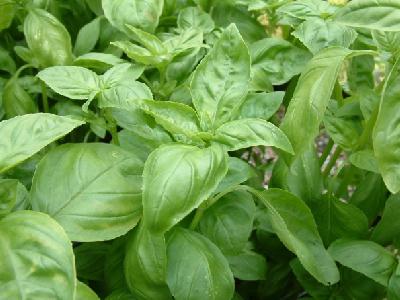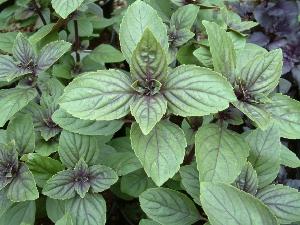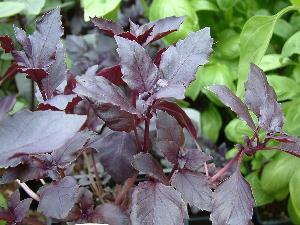Basil
By Debs Cook
History

Basil is a member of the mint family Labiatae, and is known in some countries as St Joseph Wort and Sweet Basil. With its wonderful aroma and flavour, basil is one of the most popular and widely grown herbs in the world. Primarily basil is associated with Italian cooking, so it may surprise you to discover that basil originated in the far eastern countries of India and Thailand?
There are some indications that basil may have originated even farther east than Indian. Ancient records from 907 A.D. mention sweet basil in the Hunan region of China. It migrated west as whole plants, mainly because it could be grown easily indoors away from frost exposure. Today, basil is not only used for food flavouring, but also in perfumery, incense and many herbal remedies.
Folklore
Basil supposedly derives its name from the terrifying basilisk, a half-lizard, half-dragon creature with a fatal piercing stare according to Greek mythology. The basil plant was considered to be a magical cure against the look, breath or even the bite of the basilisk when a basil leaf was medicinally applied. Although this story moved into the realm of fable, basil was still considered a medicinal cure for venomous bites. In keeping with its hostile status, later Greeks and Romans believed the most potent basil could only be grown if one sowed the seed while ranting and raving.
Basil is said to bring wealth to those people that carry it on their person, safely tucked inside their pockets. It can help ensure that your mate remains faithful and brings good luck to a new home. It has been used to purify and protect and is said to guard a person from evil.
To the ancient Romans, basil was a symbol of hatred, yet basil eventually became a token of love in Italy. Young maidens would wear a sprig of basil in their hair to profess their availability. Basil is regarded in a similar manner in Romania where if a boy accepts a sprig of basil from a girl, it means they are engaged to be married.
Description

Ocimum kilimanscharium x
Ocimum basilicum purpurescens
Basil ranges in height from 23cm to 45cm and has a spread of approximately 23cm. There are a variety of leaf shapes, sizes and colours, the colours rangeing from green through to red and purple, dependant on the variety. There are more than sixty different varieties of basil, each with its own distinct scent and flavour. These include hints of lemon, lime, thyme, clove, cinnamon and anise.
Although basil is an annual, the tips are often pinched out to prevent it from flowering, thus extending its growing period.
Growing
Basil prefers to grow in well drained soil, in a sunny, warm situation, that can also offer some protection from the mid day sun. The easiest way to start basil from seed is to sow the seeds directly into the garden. This isn't always possible in colder climates, so start your basil indoors in mid-spring. Seedlings should not be put outdoors until all danger of frost has past and the plant has four true leaves. Plants can also be made by taking cuttings from old plants. Once plants are established, pinch out the top to encourage a bushier plant. Frequent harvesting of the outer leaves will prolong the life of the plant. Basil leaves have the best flavour just before the plant flowers, and if you plan to preserve some of your basil or make a big batch of pesto, this is the best time to harvest.
Preserving

Ocimum Basilicum
Fresh basil is the perfect candidate for freezing, either whole or chopped. Blanch whole leaves for two seconds, plunge into iced water, pat dry and place in airtight bags in the freezer. The flavour will be stronger if you don't thaw the leaves before using. Another way to preserve basil is to put whole or chopped fresh leaves into an ice cube tray and cover with water before freezing. Once frozen, remove the basil cubes from the tray and put into an airtight bag. Use the cubes in soups, stews or sauces. Frozen basil should be used within four months.
Basil is readily available in dried form, but pales into insignificance in comparison to fresh basil. Dried basil should be stored in a cool, dark place away from heat and light.
General Use
Basil in the bath is refreshing and stimulating, and is good for treating oily skin. The leaves and flowers can be dried for using in pot pourri. Growing a pot of basil in the kitchen is useful as basil is said to repel flies, and mosquitoes.
Medicinal Use
Basil tea is said to help with dysentery, nausea and stomach distress due to gas. Taken as a tea it can be used to help relieve morning sickness and headaches. To relieve sore gums, swish out the mouth with a tea made from eight basil leaves in a cup of boiling water. A basil leaf tucked into the mouth over an ulcer and kept there for as long as possible will help to ease the pain. In Elizabethan times basil was an ingredient in snuff, used to help 'clear' the brain and soothe the headache. Basil essential oil is used in aromatherapy to alleviate depression, fatigue and anxiety. It makes an excellent skin tonic and assists hair growth.
Culinary Use
Basil has a warm, resinous, flavour and aroma that resembles that of cloves. The leaves are best used fresh and added only during the last few minutes of cooking. Basil works well in combination with tomatoes. Use as a garnish for vegetables, chicken and egg dishes.
You will never get the full flavour when using dried basil, so keep this in mind when substituting dried for fresh. However, if you find yourself in dire need and without fresh basil, use one-third the amount of dried basil substituted for fresh. One tablespoon of fresh chopped basil equals one teaspoon dried. When substituting fresh for dried, triple the amount.
Pounded with garlic and olive oil into a paste, basil is the prime ingredient in pistou soup, a Mediterranean speciality. In Italy, pine nuts and sometimes grated hard cheese are added to the paste to make pesto. Both pistou and pesto come from verb roots meaning to pulverise, as with a pestle and mortar. Younger leaves are preferable for pesto. Pesto is most often served with pasta; however, enzyme reactions between basil and flour can cause the pasta to turn brown in colour. When serving pesto with pasta, add a squeeze of lemon juice to the pasta cooking water to help keep the pasta from turning dark. Basil is a perfect candidate as a flavour for infused oil, but doesn't work as well with vinegar that you plan to store for a long time. It is one of the flavouring ingredients for the liqueur, Chartreuse.
Recipe:
Ham and Basil Breakfast Omelette
- 1 Tsp Olive Oil
- 4 Large Free Range Eggs
- 6 Button Mushrooms (Sliced)
- 6 Baby Tomatoes (Sliced in half)
- 4 Slices Honey Roast Ham (Cut into thin strips about 1")
- 2 Tbsp Milk or Cream
- Salt & Pepper
- Shredded Basil Leaves
Method
Add the olive oil to a nonstick frying pan and fry the mushrooms until translucent, add the sliced ham and continue to fry until the ham is heated through. Meanwhile in a bowl add your eggs and the milk or cream and season with salt and pepper and then beat them together. Add the tomatoes to the pan and pour on the egg mixture add the shredded basil and cook until the base is set. Once the base is set put the pan under the grill and continue to cook until the top is set and golden brown.
